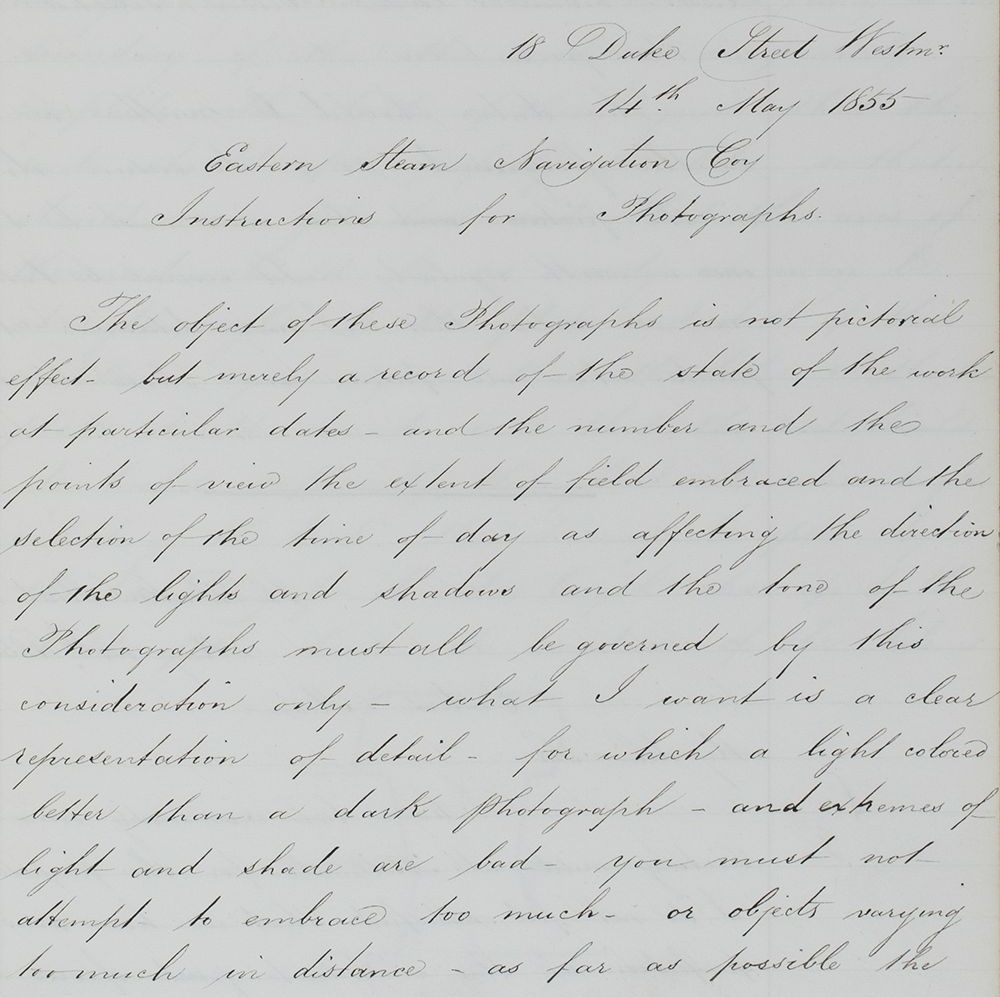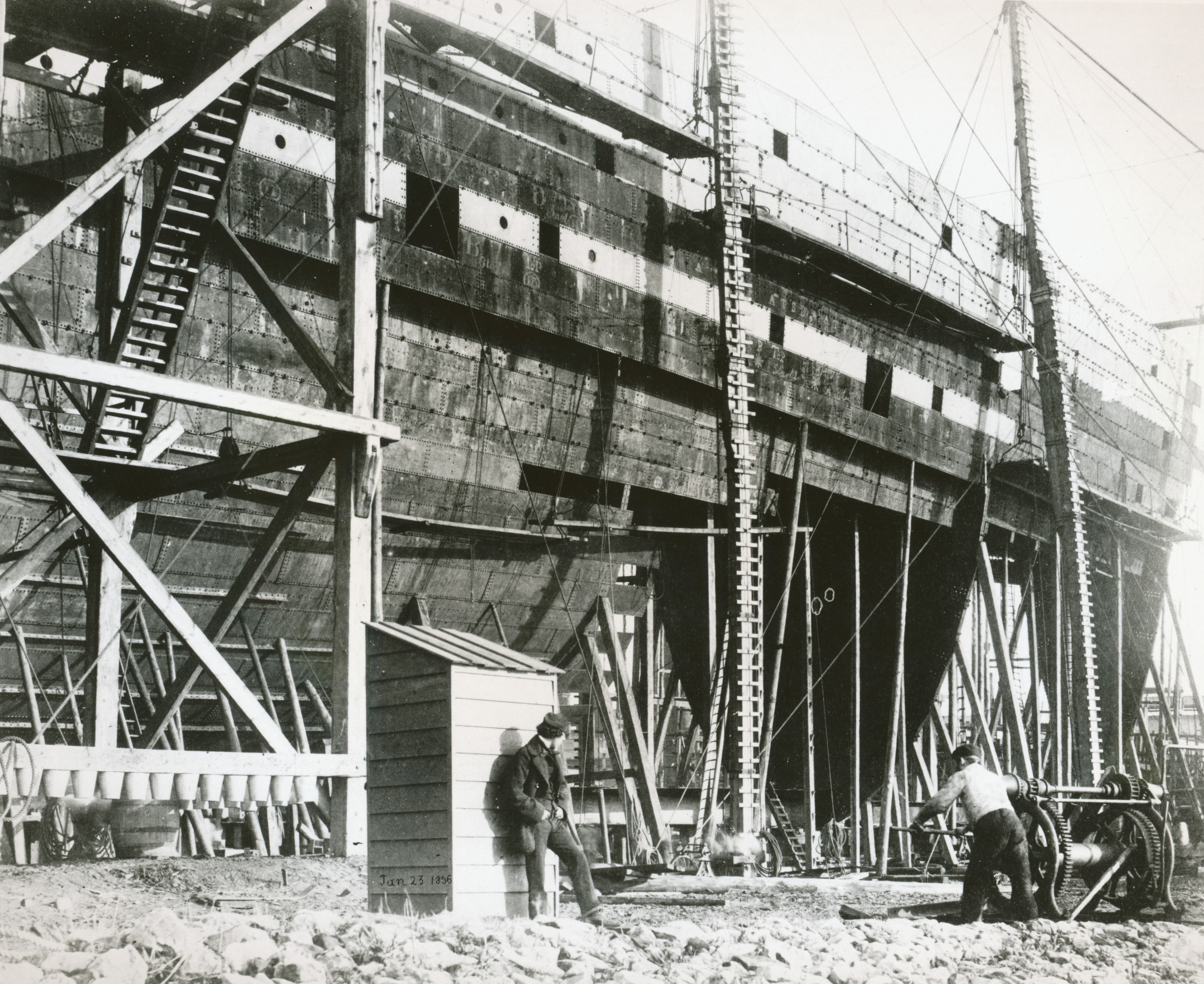Emma Howgill’s archival research into the SS Great Eastern builds connections between engineering collections.
As an archivist, I consider myself a bit of an intellectual magpie, snapping up titbits of information and combining them to provide contextual detail for whatever I am cataloguing. This process of combining information is when doing research in other archives comes in handy. As a cataloguer I have often mourned the fact that I only have one side of a correspondence, perhaps most infuriating when you only get one side of a particularly vehement argument or you have a letter full of questions but no answers. But not this time. This time, Lizzie Richmond at the University of Bath Library was able to literally illustrate points of interest that I came across while cataloguing Isambard Kingdom Brunel’s correspondence relating to the S.S. Great Eastern.
During the seven-year project to build and launch the S.S. Great Eastern, all the correspondence Brunel sent and received was copied by a secretary into a series of six letter-books. These letter-books are now being catalogued by the University of Bristol Special Collections so that every letter will have a record of its author, recipient, date and subject, available online with high-quality digital images of the pages while the original volumes can be consulted at the Brunel Institute.
The S.S. Great Eastern was the last, and largest, of Isambard Kingdom Brunel’s three great steamships. Conceived with the intention of travelling from Britain to Australia without stopping to refuel (that is being large enough to carry, as well as passengers and cargo, sufficient coal for the voyage), the Great Eastern was, at 692 feet and around 18,000 tons, the largest ship ever built; a title she retained for nearly forty years until the RMS Oceanic was built in 1899.
As a social and engineering project, the Great Eastern was so important that the company commissioned the photographers Joseph Cundall & Robert Howlett to document the monthly progress being made on the ship. These photographs were not only of interest to the directors and engineers behind the ship but were also of interest to the general public, with lithographs based on the photographs being offered for sale. The public appetite for images of this great engineering feat was also satisfied by the many stereoscopic photographs created and offered for sale, a variety of which are held in the collections of the Brunel Institute at the S.S. Great Britain.
And this cataloguing project began a chain of events connecting Bristol and Bath, both places themselves strongly connected with Brunel’s work. Visiting the University of Bath’s archives and research collections to discuss the overlap between my work and one of the University’s collections: a series of copies of letters relating to the construction of the Great Eastern, Lizzie pulled out three folders of photograph prints and asked if I had seen them before. The short answer was no, but I did remember cataloguing correspondence relating to photographs and so began a trail of research.

Returning to my cataloguing, I found a letter from December 1856 (DM1306/11/1/4/folio 56-57) from Joseph Cundall requesting immediate payment for photographs he was commissioned to take of the construction of the Great Eastern. Eighteen months previously, there had been correspondence between Isambard Kingdom Brunel and his shipbuilder John Scott Russell over these photographs (DM1306/11/1/1/folios 270-285), culminating in Brunel’s decision on 8 November 1854 to commission periodic photographs taken recording the progress made on the construction of the ship (DM1306/11/1/1/folio 304-305). Then comes one of the most interesting letters, two pages of Instructions to Photographers (DM1306/11/1/2/folios 85-86), written after Brunel expressed dissatisfaction with the overly artistic images that had initially been produced.
In typical micro-managing style, Brunel, in his ‘Instructions to Photographers’ had much to say about the style of the photographs, and it is clear from the prints that photographers Joseph Cundall and Robert Howlett took these on board. Brunel is clear in his memo that the photographs are to be a documentary, not aesthetic project and warns against too much dramatic contrast in light and shadow which might obscure the engineering details. He also demands that the photographs show as much of the ship as possible, sometimes using two plates to cover the whole length of the vessel and that each month’s photograph be taken, as near as possible, from the same spot to provide a continuous, reliable record.
Successive photographs show the progress made on the ship as the giant bulkheads are gradually covered by the double layer of iron sheathing of the hull which also perceptibly grows along the ship and the great cages to hold the paddle wheels appear on the sides of the ship. Each image also, like a Victorian game of ‘Where’s Wally’, has the date hidden, sometimes on a baulk of timber, sometimes on the side of a workman’s hut.
Robert Howlett went on to document the first attempt at launching the S.S. Great Eastern, during which he took what may well be one of the most iconic photographs of the Victorian age, an image of Brunel, stovepipe hat on head, ubiquitous cigar in mouth, standing against the giant launching chains of the S.S. Great Eastern. I certainly had never known that this photograph was merely one of a series of photographs, an almost accidental part of a wider series, despite its present recognition as one of the first examples of environmental, rather than studio, portraiture.
Without the images held at the University of Bath, I would have catalogued Brunel’s Memorandum with cursory interest, idly wondering what happened to the photographs and thought little more about it. Finding actual copies of these images however has provided me with a practical understanding of the process of the building of the S.S. Great Eastern which I would otherwise never have had. Through these images I can see the double hull that Brunel was so proud of as well as the bulkheads that compartmentalised the hull and which Brunel insisted on as a flood and fire precaution.
The images also illustrate the slow, tortuous process of launching which began on 3 November 1857 and was finally completed on 31 January 1858 and connect to one of the most famous photographs of the Victorian age. These images, especially when taken in conjunction with the stereoscopic images at the Brunel Institute, also demonstrate the great public excitement that the project evoked.
References used for the Brunel letter book can be traced via the University of Bristol’s online catalogue.
